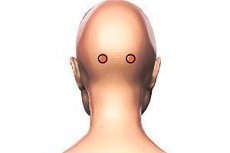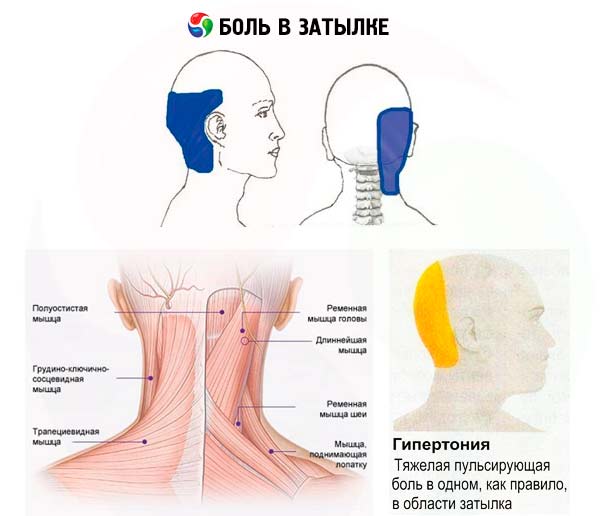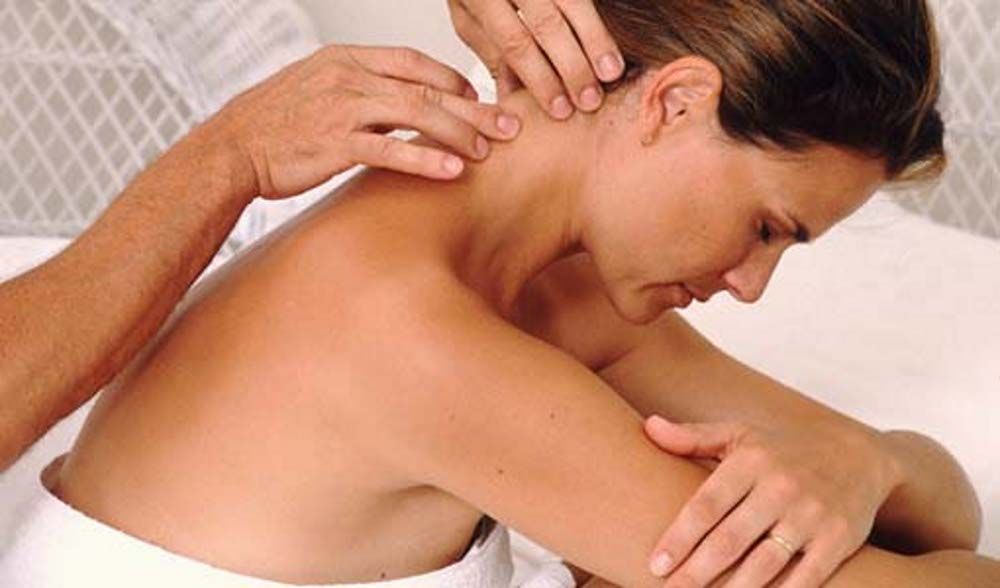Headache in the nape: causes, treatment
Last reviewed: 23.04.2024

All iLive content is medically reviewed or fact checked to ensure as much factual accuracy as possible.
We have strict sourcing guidelines and only link to reputable media sites, academic research institutions and, whenever possible, medically peer reviewed studies. Note that the numbers in parentheses ([1], [2], etc.) are clickable links to these studies.
If you feel that any of our content is inaccurate, out-of-date, or otherwise questionable, please select it and press Ctrl + Enter.

Pain in the nape is one of the most insidious pains, because one can never say for sure whether it's the head itself or whether there are problems with the cervical vertebrae. Often a strong tension in the cervical extensor, which is located directly above the back of the head, can cause a headache. Pain in the occipital part of the neck can be manifested by tilting, turning the head, touching.
What causes a headache in the back of your head?
The most common cause of pain in the nape - cervical spine disease: spondylitis, subluxations in small intervertebral articulations, posttraumatic sprains, osteochondrosis. Such headaches in the occipital part usually grab the entire nape and become stronger when the head moves.
No less often patients are victims of cervical spondylosis - this is a chronic disease of the spine, in which the coracoid and spine-shaped osteophytes grow at the edges of the vertebral bodies. Many mistakenly refer to the symptoms of the disease as "deposition of salts," but this is misleading. In fact, there is deformation of ligaments in the cervical region, mainly in hypodynamia. The first symptoms of spondylosis - a headache in the back of the head, eyes, ears, even at rest. The pain is particularly pronounced when the head moves. When you click on the "sick" point or deflect the head back, an occipital headache is felt.
Myogeelosis of the cervical region can also often be found in patients. It usually occurs because of the tightening of the muscles. In turn, painful processes in the neck and neck can occur after a long stay in draft or incorrect posture, with an incorrect posture, with strong physical exertion. Defining symptoms are headache in the neck, shoulder pain, limitation of mobility of the shoulder joint and pain while moving shoulders, dizziness.
Often the cause of pain in the nape can be not only a disease, but a large amount of mental and physical exertion. So, it is likely that after stress or prolonged psychological stress in the nape of the pain may appear. In fact, the same symptoms also occur with prolonged mental stress. For a long time to sit in an uncomfortable position, doctors also do not recommend.
Neuralgia of the occipital nerve causes spontaneous and sharp pain in the nape. Unpleasant sensations can flow from the neck to the back, the ear and even the lower jaw, while in the nape of the neck can be constantly felt pressing pressure. This is most clearly seen when the head turns or sharp movements. With prolonged neuralgia, hyperstasy (hypersensitivity) in the entire neck can form . You can earn neuralgia with cervical vertebra, osteoporosis, spondyloarthrosis, hypothermia or colds.
As for the above hypertension, it can also make the nape of the pain. Arterial hypertension mostly worries its victims in the morning.
Cervical migraine, perhaps, in general, one of the most common diseases of our time. With migraine, a person feels a scratchy pain in the back of the head, temples, in the forehead area, there is a sensation of fog and sand in the eyes, it is impossible to concentrate, noise in the ears, dizziness and even nausea. In order not to confuse the cervical migraine with hemicrania, you just need to apply pressure on the vertebral artery at the junction of the mastoid and spinous processes of the first cervical vertebra. It is better that the doctor does this. With increasing pain, you can be sure that this is a cervical migraine.

Launched osteochondrosis may well lead to in ertebrobazilyarnomu syndrome, which will bring with it, and the pain in the back of the head with the noise in the ears and dark eyes. Among other symptoms: nausea, hiccough, pale, deterioration of coordination of movement. If you have this disease, you need to be very careful with the movements of the head, otherwise an abrupt sudden movement can lead to a sudden fall without losing consciousness.
Pain in the back of the head can occur if the exercise is incorrect. Constant loads, especially if they are performed without taking into account the physical capabilities of a particular person, can lead to a permanent headache in the nape of the neck. Occipital headache can occur even in a state of rest, during reading, sitting at a table, during gymnastics. Sometimes there is a feeling that a hat is put on his head, although there is no hat. Usually, such pain in the occipital part of the head does not have a migraine pulsating character, but in addition to pain directly in the back of the head, the patient can also complain of pain in the muscles in the neck, forehead, temples and the occipital part of the head. Touching the sick muscles is usually unpleasant, and in general, the additional pressure on these muscles can only increase pain. Worse when the pain manifests itself in a state of rest. With such symptoms doctors advise to move the neck as rarely as possible, so that the headaches in the occipital part do not increase.
Symptoms of pain in the back of the head
If patients are concerned about the pain in the nape, they often complain of the following accompanying symptoms:
- noise in the head and ears,
- feeling of pressure on the back of the head,
- The throbbing pain that flows from the neck to the neck is manifested during orgasm or exercise,
- morning shooting pain in the neck when moving head,
- dizziness,
- numbness of limbs,
- darkening in the eyes,
- "Gags" in the ears,
- nape hurts all week,
- sensation of pressure on the head,
- "Drunk" condition,
- you can not concentrate,
- discomfort in the upper jaw,
- it seems that my ears are puffy.
Who to contact?
How is pain in the occipital part of the head treated?
Doctors recommend several useful exercises that will help to weaken, and then completely get rid of some of the causes of pain in the nape, or at least greatly relieve the pain.

The easiest way to ease the pain in the occipital part of the head, especially that arose against the background of mental, physical or psychological overload - is to mechanically relax and stretch the tight muscle. To do this, you need a network on a chair with a backrest not leaning on it. Take, literally and figuratively, your head in your hands. At the same time, the thumbs touched the cheekbones, and the other fingers should be on the back of the head. Now you have to tilt your head back, your hands should not let your head fall. Perform the exercise is enough for about seven seconds, after which you need to relax and gradually lean back in the chair. Exercise can be repeated if it does not become easier, but you need to be very careful that during its performance in the neck there were no crunches.
Doctors say that the pain in the nape, especially if it lasts for a long time, can be an indicator of a more serious disease, perhaps even a systemic one, which requires a full examination and revealing the true causes of the disease. You may need a pill for headache, or high blood pressure. Therefore, for any complications and pain intensification in the occipital part of the head, you should consult a doctor.


 [
[